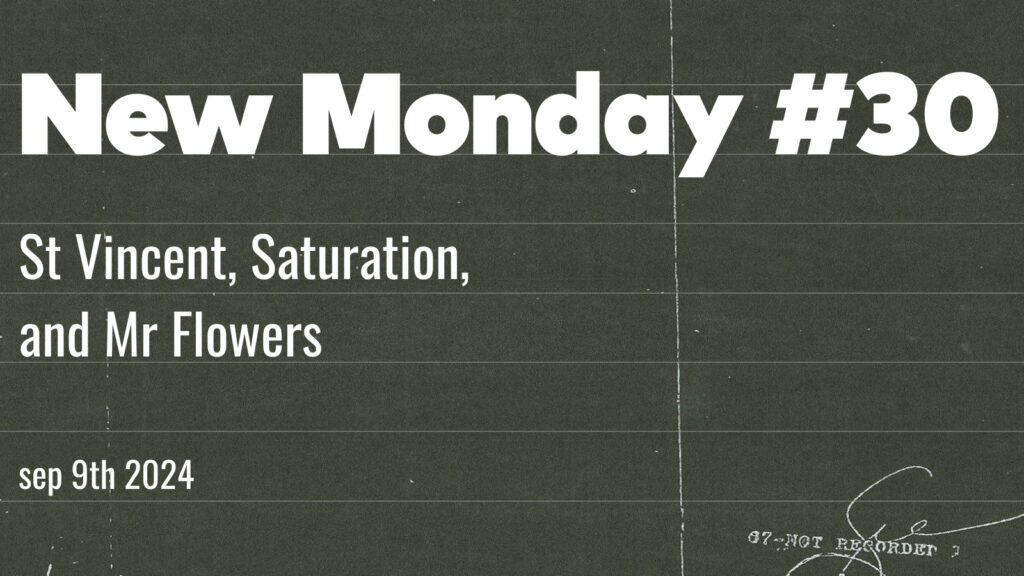New Monday #30
Happy Monday, all.
Fall appears to be here in the Northern Hemisphere. Cold days ahead. This will warm you up:
What a cool record! Funky flinky guitars, gang vocals, live in-the-room and in-your-face drums, and god knows what sort of insanity for the FOUR MINUTE VAMP OUT!
St Vincent
St. Vincent (also known as Annie Clark) has always been interesting, but her latest album is fantastic. Self-produced, it’s a playground of ideas, noises, styles, production techniques, and wonderful engineering. Cian Riordan appears to be mixing things out of this space here. Modest but dang, the results are amazing.
Perhaps most impressive is Ms. Clark’s songwriting. She’s really notched it up on this record.
Busy Days at Korneff
We’ve been really busy at Korneff working on a new plug-in that will be out next week, and that is why this particular New Monday is a thin one. But let’s jump into something briefly because it plays a part in what you’ll see next week.
The Hierarchy of Saturation
This topic is related to last week, and EQ, and the math involved, overtones and such.
Compression -> Saturation -> Distortion
The first thing you get when you turn up the gain is compression.
As you increase the input level into something (analog gear, a digital simulation) eventually, the device runs out of ability to correctly reproduce the waveform. When this happens, the peaks of the waveform clip—they square out a bit. The top of the waveform is literally getting clipped. When you clip a waveform, it is a type of compression, because the dynamic range is getting a wee bit smaller. Please note that this compression has an infinitely fast attack time. This does NOT make things punchy sounding because no transients can get through un-clipped. Tape compression, which happens on analog tape, sounds great but it doesn’t make things sound punchy; it does the opposite.
Then you get saturation.
A clipped waveform, even a slightly clipped waveform, generates harmonic distortion. That is, when you clip a waveform as it feeds into something, it comes out with additional sonic information mixed into it. At low levels of clipping, your ear won’t notice, but as you increase the level and the amount of clipping, the additional harmonics will become more noticeable. People seem to call this saturation.
What you’ll first notice is that things sound brighter. This is because harmonic distortion goes up the scale, up in frequency. Saturation makes things apparently brighter. A saturated kick doesn’t produce more lows, it produces more highs. And it also LOSES punch because of the clipping of transients mentioned above.
Then you get distortion.
There comes a point when the added harmonic distortion becomes really loud, and our ear no longer hears it as just an increase in highs, but as distortion as a phenomenon. A cranked-up guitar amp is designed to do this.
When you slam a signal to audible distortion, remember that it’s compressed, saturated and distorted — all of that stuff happens. Distorted signals are NOT PUNCHY. They’re clipped.
Good Math and Bad Math
The harmonic elements added to a saturation/distorted signal are mathematically related to the signal feeding in. Clipped adds the 5, the octave, the octave above that, the third, etc. It gets very complex because harmonics are added mathematically to the harmonics that are already part of the original signal.
This is why if you have a tuning issue with an instrument, the more it gets distorted the more out of tune it will sound.
Some devices produce harmonics using math that sounds good. Some produce harmonics that are mathematically ugly sounding. Double a guitar part up with a tube amp and a solid-state amp, and the two parts might sound rather out of tune, or even phase cancel somewhat when mixed together. Good math and bad math don’t always mix.
Playing around with this
If you’re going to add saturation to a track, remember that the signal will compress and get brighter. This makes saturation very useful as a mixing element, and if a track just isn’t quite sitting correctly, add saturation by either using a saturation plug-in or perhaps turning up the input level a bit. You might like the result.
All of our plug-ins saturate in a pleasant, analog way. Not all digital products do this, so use your ear.
Saturation = compression + brightness EQ.
It doesn’t make things more bassy, but it might make something sound warmer, and it might help a low part to stand out better on small speakers.
Saturation doesn’t make things punchier.
I wrote more on this here.
Farewell, Mr Flowers
A few weeks ago there were three New Mondays (21, 22, 23) that touched on English session bassist extraordinaire Herbie Flowers. Mr. Flowers died on September 5th at 86 years of age.
Aside from being a wonderful musician, Herbie Flowers had a great sense of humor. He co-wrote a novelty hit, Grandad, that actually reached #1 on the English charts in 1970. It was sung by an actor, Clive Dunn, in the voice of an old man, looking back on the life he had as a boy. There’s a children’s choir for the choruses singing, “Grandad, you’re lovely.”
As far as novelty songs go, it’s on the depressing side.
But it’s a proper send-off for Mr. Herbie Flowers, who was a grandad, and evidently a lovely person. He plays bass on this as well as tuba. Hear it here.
Farewell, Mr Flowers.
Look for a new plug-in next week!
Warm regards,
Luke

A quote by St Vincent (Saint Vincent de Paul)
 |
A quote that some knucklehead on the internet thinks is by St Vincent
 |

